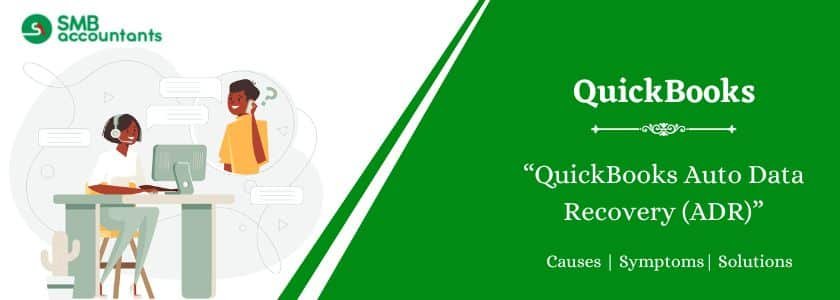QuickBooks Auto Data Recovery is an important feature in the QuickBooks application. It helps recover lost data and is very useful when files become corrupted, go missing, or get damaged. Let’s take a closer look at this tool to understand how it works and how to use it fully.
QuickBooks has worked to improve the user experience by adding helpful features. One of these is QuickBooks Auto Data Recovery Services. This service started in 2010, first for QuickBooks Pro/Premier, and later added to QuickBooks Enterprise in 2012. These features help recover lost data using QuickBooks Auto Data Recovery.
This feature works by automatically creating a local backup copy of your company file. It uses two different Sybase technologies: “auto-replication,” which creates a copy of your QuickBooks Company (.QBW) file and the QuickBooks Transaction Log (.QBW.tlg) file,
Table of Contents
- 1 What is QuickBooks Data Recovery File Extension?
- 2 Why Does QuickBooks Data Disappear or Get Deleted?
- 3 How To Recover Lost Data With QuickBooks Auto Data Recovery Tool?
- 4 How to Recover Manually Deleted Files in QuickBooks Desktop?
- 5 Frequently Asked Questions
- 5.1 Q 1: How do I recover lost data in QuickBooks?
- 5.2 Q 2: How do I rebuild data in QuickBooks?
- 5.3 Q 3: What to do if I am not able to identify the .QBW.adr and .TLG.adr files for QuickBooks Auto Data Recovery Tool?
- 5.4 Q 4: What is the QBW TLG file in QuickBooks?
- 5.5 Q 5: How do I recover data from QuickBooks Desktop?
- 6 Adams Williams
What is QuickBooks Data Recovery File Extension?
QuickBooks Auto Data Recovery automatically makes a backup copy of your company file and saves it in a separate folder called the QuickBooksAutoDataRecovery folder. This folder contains .QBW.ADR and .QBW.TLG.ADR files, which are updated regularly.
Get Expert Advice to Fix All Accounting & Bookkeeping Problems

Why Does QuickBooks Data Disappear or Get Deleted?
- If you upgrade the company file to its higher version.
- When you fail to upgrade the software properly.
- External interruptions while performing any task.
- Presence of multiple company files.
- Loss of company files from the hard drive.
- Unwanted power disruption.
- Crashing of the device while working on QB.
- Corrupt QuickBooks DataBase.
- Mistakenly deleting the files.
How To Recover Lost Data With QuickBooks Auto Data Recovery Tool?
Here are the methods you can use to recover QuickBooks data:
Method 1: Using the Original .TLG File with .QBW.adr File
To recover a QuickBooks file from your hard drive using the original Transaction Log File (TLG) and the Auto Data Recovery (ADR) version of the company file, follow these steps:
- Create a new folder named “QBTest” on your desktop.
- Locate the folder where the company file is saved. You can find the location on the Product Information screen (F2 or Ctrl + 1) or the No Company Open Window.

- Copy the corresponding .tlg file from the company file’s folder and paste it into your desktop’s “QBTest” folder. Make sure you’re able to view file extensions.
- If you can’t identify the .tlg file, follow these steps:+
- Open Windows Explorer.
- Click “Organize” and select “Folder and Search Options.”
- For Windows 10, 8.1 & 8, Click “View” and choose “File Name Extensions.”
- Uncheck the “Hide Extensions for known file types” option.
- Click “Apply” and Ok.

- Copy the corresponding .tlg file of your company file, and paste it to the QBTest folder on your Desktop.
- Open the QuickBooksAutoDataRecovery in the exact location as your company file
- Copy the .QBW.adr file and paste it into the “QBTest” folder. A.QBW.adr and .tlg files should be in the “QBTest” folder.

- Right-click the .QBW.adr file on your desktop’s “QBTest” folder and select “Rename.” Delete .adr from at end of the file.

- Open QuickBooks and access the company file saved in the “QBTest” folder.
- Use your account register to verify that all transactions are present.
- Run the QuickBooks Verify Data Utility to ensure the integrity of this company file. You can find this option in the File menu under Utilities and select Verify Data.
- If the copy of the company file in the “QBTest” folder is fine, move the damaged company file to a different location.
- Transfer the copy from the “QBTest” folder to the original location as the last step in the QuickBooks recovery process.
Method 2: Make Use of .QBW. adr and .TLG.adr Files To Recover Recent Transactions
Additionally, utilize the ADR version for the .QBW and .TLG files. This will allow you to recover all data except for transactions from the past 12 hours using QuickBooks’ restore deleted transaction software.
- Create a new folder on your Desktop named QBTest.

- Open the folder where the company file is saved; look for the QuickBooksAutoDataRecovery folder.

- Tip: You can check the location of the company file on the Product Information screen (press F2 or Ctrl+1 on your keyboard) and No Company Open window.
- Look for the .TLG.adr and .QBW.adr files. These files have the same name as your company file.
- Show file extensions
- If you cannot identify the .TLG.adr and .QBW.adr files, perform these steps to show file extensions:
- To open File Explorer, press Windows+E on your keyboard.
- Select Organize, then choose Folder and search options.
- Select Hide extensions for known file types.
- Select Apply, then OK.
- Copy the .TLG.adr and .QBW.adr files and paste them to the QBTest folder.
- In your QBTest folder, remove the .adr from the end of the file names. That should give you .qbw and .tlg files in your QBTest folder.
- Open QuickBooks.
- Open the company file that is saved in your QBTest folder. Use your account register to verify all transactions are there.
- To check the data integrity of the recovered file: in the top left, select File, then Utilities, then Verify Data.
- If this copy of the company file is good, move the damaged company file to a different location and transfer the copy from QBTest to the original location.
How to Recover Manually Deleted Files in QuickBooks Desktop?
- At first, you need to open the search box, followed by typing *qbw, and then you need to hit the “Enter” button.
- In the next step, you are required to search for the copy as shown in the list of the company’s files
- Now, you need to note the file, followed by right-clicking on it. And then, you need to choose the option for “Properties.”
- As you move ahead with the steps, make sure that you go to the General tab. After that, you are supposed to check the file to see if is named a QuickBooks Company File or not
- In the next step, make sure that you have used the Date Modified feature, followed by discovering the most updated files
- As soon as you have found the most updated files, you are required to copy them to a CD
- And, just after the file is copied, you are supposed to remove all the residual files as soon as possible.
- In the end, all you need to do is to paste the copied file into the same location where it was kept before
Need Professional Help?
To recover lost data with the QuickBooks Auto Data Recovery Tool, visit smbaccountants.com for step-by-step guidance and expert support. Don’t wait—contact the professionals today to restore your company file quickly and securely.
Frequently Asked Questions
Q 1: How do I recover lost data in QuickBooks?
Ans: follow these steps:
- Open QuickBooks and navigate to the “File” menu.
- Choose “Open or Restore Company.”
- Opt for “Restore a backup copy” and click “Next.”
- Select “Local Backup” and then click “Next.”
- Browse your computer to locate your backup company file.
- Choose a destination folder to save your restored company file.
Q 2: How do I rebuild data in QuickBooks?
Ans: Rebuild your company file data
- Navigate to the “File” menu, then select “Utilities,” and choose “Rebuild Data.”
- QuickBooks will prompt you to create a backup before it begins rebuilding your company file.
- Select the location where you wish to save the backup, then click “OK.”
- After the rebuild process is finished, click “OK” when you see the message confirming that the rebuild has been completed.
Q 3: What to do if I am not able to identify the .QBW.adr and .TLG.adr files for QuickBooks Auto Data Recovery Tool?
Ans: Follow these steps:
- To open File Explorer on your Windows system, press the Windows + E keys.
- Within File Explorer, select the “Organize” option.
- Then, choose “Folder and search options.”
- Then, choose “Folder and search options.”
- Then, choose “Folder and search options.”
- Choose “File name extension.”
- Click on the option “Hide extensions for known file types.”
- Click the Apply button.
- Click OK, and you’re done.
Q 4: What is the QBW TLG file in QuickBooks?
Ans: The QuickBooks transaction log file serves as a record of all impending changes set to be made to the company file (.qbw) before they are officially implemented. This file is located in the same folder as the company file and is automatically generated by QuickBooks.
Q 5: How do I recover data from QuickBooks Desktop?
Ans: Restore a backup company file:
- Navigate to the File menu in QuickBooks and choose “Open or Restore Company.”
- Opt for “Restore a backup copy” and click Next.
- Select “Local Backup” and proceed by clicking Next.
- Browse your computer to locate your backup company file.
- Choose a folder to designate where you want to save your restored company file.

Adams Williams
Adams Williams is a seasoned accounting professional with over 4 years of experience in bookkeeping, financial reporting, and business accounting solutions. Specializing in QuickBooks software, Adams combines technical expertise with clear, accessible content writing to help businesses streamline their financial processes. His insightful guides and how-to articles are crafted to assist both beginners and seasoned users in navigating accounting software with confidence.


